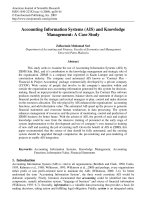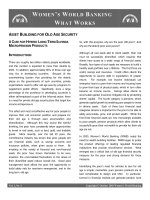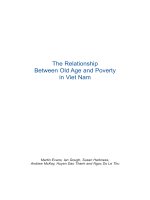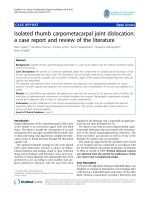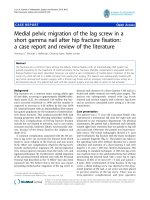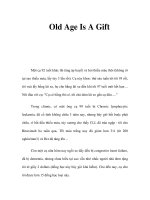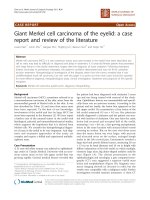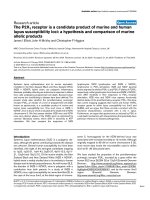ASSET BUILDING FOR OLD AGE SECURITY - A CASE FOR HYBRID LONG-TERM SAVINGS MICROPENSION PRODUCTS potx
Bạn đang xem bản rút gọn của tài liệu. Xem và tải ngay bản đầy đủ của tài liệu tại đây (240.89 KB, 12 trang )
Vol. 1, No. 4 Copyright © October 2003 Women’s World Banking
WOMEN’S WORLD BANKING
WHAT WORKS
ASSET BUILDING FOR OLD AGE SECURITY
A CASE FOR HYBRID LONG-TERM SAVINGS
MICROPENSION PRODUCTS
INTRODUCTION
There are roughly two billion elderly people worldwide,
and this number is expected to more than double by
2025. In addition, approximately 80% of those over age
sixty live in developing countries. Because of the
overwhelming burden that providing for the elderly
places on the governments of such countries, private
organizations need to offer old age security programs to
supplement public efforts. Specifically, since a large
percentage of the workforce in developing countries is
either self-employed or part of the informal sector, there
is a need for private old age security plans that target low
income entrepreneurs.
The safest and most cost-effective way for poor people to
improve their net economic position and prepare for
their old age is through asset accumulation and
diversification. Although this may sound like wishful
thinking, the poor have consistently taken opportunities
to invest in real assets, such as land, gold, and tradable
goods. More recently, over the last 20 years, the
microfinance industry has shown that poor people will
use financial assets, such as savings accounts and
insurance policies, when given access to them. By
investing in this variety of financial and non-financial
assets, the poor have shown themselves to be savvy
investors: the uncorrelated fluctuations in the values of
their diversified assets reduce overall risk. Good asset
management tools afford the poor the opportunity to
build safety nets for near-term emergencies, and in the
long term, old age.
So, with this progress, why are the poor still poor? And
why are the elderly poor even poorer?
Although all real assets add to client wealth, their risk
must be successfully diversified, which requires that
clients have access to a wider range of financial assets.
Broadly, four types of such assets are necessary to build a
healthy asset portfolio over a lifetime. The first three are
credit, savings and insurance. Credit offers clients the
opportunity to assume debt in expectation of greater
return. For example, low income individuals use
enterprise loans to grow their income and housing loans
to grow their base of physical assets, which in turn often
become an income source. Savings allow clients to
accumulate capital; insurance mitigates risk by protecting
clients’ capital. The fourth category is pensions, which
generate capital growth by enabling poor people to invest
in diverse assets. Each of these four financial asset
categories streams is important for the poor to be able to
safely accumulate, grow, and protect wealth. While the
first three financial assets are now increasingly available
to poor people, pension products which allow clients to
successfully grow their net wealth to provide for their old
age are not.
In 2000, Women’s World Banking (WWB) noted the
need for wealth building facilities. WWB began to probe
the product offerings of leading regulated financial
institutions that provide microfinance services. What
emerged was a critical lack of old age financial security
measures for the poor and strong demand for those
measures.
Identifying the poor’s need for vehicles to save for old
age is simple; meanwhile, pure pension products are at
best complicated to design and offer. In particular,
turmoil in financial markets can generate pension fund
Vol. 1, No. 4 Copyright © October 2003 Women’s World Banking
- 2 -
losses. How can microfinance make a difference?
Carefully. WWB believes that financial institutions could
gain experience in wealth building products for the poor
by beginning with a hybrid micropension-microsavings
product. This would be an interim way for institutions to
help the self-employed poor in accumulating assets, while
designing more refined pension products that respond to
client preferences and meet regulatory requirements. A
hybrid product would also enable institutions to hone
their financial planning and asset management skills,
before offering pure micropension products.
Learning from mistakes, pensions for the poor should:
directly link contributions and benefits to encourage
aggressive savings; and be voluntary, rather than
compulsory, to provide the poor with financial flexibility.
The terms and product attributes offered will clearly
determine the success of the product. There are
advantages and disadvantages to offering fixed versus
floating interest rates, flexible versus rigid withdrawal
options, and various product terms. There are merits to
offering lotteries and mobile banking for marketing and
distribution. This What Works note suggests key
measures in the design and implementation of customer-
focused old age savings products.
THE CASE FOR PRO-POOR ASSET BUILDING
PRODUCTS
Saving for Old Age Requires Capital Growth
The financial goals of the poor are the same as those of
the rich: financial leverage, capital preservation, risk
mitigation, and capital appreciation. To achieve these
goals, poor people need to diversify their wealth among
different financial products.
The poor are sophisticated in their asset allocation, using
a variety of real and financial asset building vehicles. One
way the poor diversify is by investing in a variety of assets
used to produce goods and services, or real assets:
microbusinesses, gold, land and livestock. Although the
relative values of these real assets constantly fluctuate,
when held concurrently, their fluctuations can offset one
another, producing more constant rates of return for
investors.
In addition to investing in a variety of the real assets listed
above, access to key financial products helps the poor
build wealth. WWB identified needs-appropriate credit,
savings, insurance, and pensions as key drivers of long
term financial health among the poor. Credit allows
clients to harness debt to build income and assets.
Savings preserves capital value. Insurance mitigates risk.
Pensions grow capital.
Formal Financial Products and their Purposes
Capital
Preservation
Risk
M itigation
Capital
Appreciation
Financial
Leverage
Chart 1: Formal Financial Product Classes
Vol. 1, No. 4 Copyright © October 2003 Women’s World Banking
- 3 -
This note focuses on pensions, but briefly addresses
savings and insurance. Credit, although critical to
financial health, shares few features with pension funds.
In contrast, pensions are savings for old age. Similarly,
pensions resemble insurance by pooling capital. Because
of these similarities, when designing pension funds for
the poor, it is important to: gauge the poor’s demand for
those savings and insurance products already available;
identify the weaknesses of these products; and if possible,
incorporate off-setting strengths into pension product
design.
Savings products, such as fixed deposit schemes, provide
the poor with a means for secure capital accumulation.
Such security represents the major competitive advantage
of financial over real assets. Financial assets bear the risks
of inflation, currency devaluation and institutional
insolvency, but experience shows that formal savings are
less risky than real assets. For example, MicroSave found
that 99% of clients saving in informal instruments in
Uganda had lost an average of 22% of their previous
year’s savings, whereas only 15% of those saving in formal
structures had lost some of their savings. MicroSave
deems that formal savings are preferable because of their
lower likelihood of loss and their lower average relative
loss (the “ratio of amount lost to amount saved”).
Average Amounts Saved and Lost in the Last 12 Months by Sector
0
50
100
150
200
250
300
350
400
450
Formal Semi-Formal Informal
Sector
US Dollars (Converted at Ush.1,600:$1)
0%
20%
40%
60%
80%
100%
120%
The Potential Micropension Market,
Already Huge, Is Growing
Populations worldwide are aging. Defining the elderly as
those over 60 years old, there are roughly two billion
elderly people worldwide. This number is expected to
more than double by 2025 from 1.6 billion to 3.8 billion.
1
Meanwhile, family care systems continue to weaken. Joint
family systems and other traditional models for old age
security are less willing and able to cope with
encumbering medical and other expenses associated with
old age. As a result, 50% of participants in a WWB focus
group of India’s SEWA Bank clients specified that they
would depend on their savings for old age security. Given
this high level of interest, these clients and other self-
employed poor individuals need access to financial
products that can provide them with lifelong financial
security. Pensions are one such product currently
unavailable to the majority of the poor.
The Shortcomings of Current
Pension Systems
Those countries that do offer pension products typically
use a pay-as-you-go defined benefit system. “Pay-as-you-
go” means that each age group of workers pays
contributions that support the preceding age group with
the expectation that subsequent generations will follow
suit. However, as the population ages, growth of
contributions lags behind that of promised benefits:
surpluses turn into deficits. Defined benefit means that
pensioners are guaranteed a specific monthly benefit at
retirement. The pension fund, rather than the
pensioner, assumes the investment risk, and professional
money managers generally make investment decisions.
Economists, politicians, and development specialists have
suggested that public pension systems transition from
pay-as-you-go defined benefit plans to fully funded
defined contribution plans. “Fully funded” means that
workers today pay taxes to finance their own retirements
in the future. The assets have time to generate returns,
preventing unaffordable promises and the implicit debt
1
Vol. 1, No. 4 Copyright © October 2003 Women’s World Banking
- 4 -
associated with them. Defined contribution means that
workers must deposit a certain portion of their income.
Such plans can spur large-scale wealth building.
Attempting to address some of the pitfalls of pension
systems, the World Bank has played an important role in
revamping those in developing countries. The World
Bank has designed a multi-pillar pension system that it
tailors to each country context. In brief, the government
manages and funds the mandatory first pillar with
mandatory tax contributions; this pillar redistributes
income and co-insures. Similarly, private employers and
individuals regulate and fund the mandatory second
pillar with occupational and personal savings plans; this
pillar coinsures and increases overall levels of savings. By
contrast, a third pillar is managed privately, regulated by
the government, fully funded by the individual, and is
either voluntary or semi-voluntary. The multi-pillar
approach:
• redistributes wealth from the rich to the poor;
• encourages savings; and
• revives interest in saving for old age by revamping
certain pension systems that are perceived to have
failed.
However, despite strong results, pension reform is an
unfinished agenda that still focuses on systems that serve
middle to upper income formal sector workers. Even in
those countries that use the multi-pillar approach, basic
pension systems typically cover less than 35% of the labor
force. Whereas more than 80% of the workforce in
OECD countries contributes to retirement savings plans,
the corresponding values in Latin America and East Asia
are 35%, and under 30%, respectively. More strikingly,
fewer than 10% of workers in South Asia and Sub-
Saharan Africa have pension coverage.
2
Given the expected exponential increase in the elderly
population and the poor’s willingness and ability to save
for old age, it is time for the microfinance sector to build
2
“Coverage: The Scope of Protection in Retirement Income
Systems,” World Bank Pension Reform Primer. Social
Protection, Human Development Network, World Bank.
Washington, DC, September 2001.
efficient and effective vehicles to help the informal sector
save for old age.
MICROPENSION–A NEW OPPORTUNITY
Microentrepreneurs should invest for old age. First, if
carefully harnessed, investment risks can generate strong
returns. Second, the poor must invest to beat inflation.
Inflation erodes the value of money stored under
mattresses. At the same time, assuming too much risk
can also produce losses. Microentrepreneurs must strike
a balance between risk and average return through
diversification.
The risk-return continuum spans from highly secure
assets with low returns to assets with highly volatile but
higher average returns. Risk aversion depends on
individual needs and propensities, not on wealth: the
poor, as well as the rich, have varying appetites for risk.
The willingness of poor households to invest in
microbusinesses, livestock and agriculture, and wealth
building vehicles such as land and children’s education,
demonstrates their willingness to take relatively high risk
for strong potential returns. At the same time, low risk
assets, such as savings programs with fixed return, are a
vital part of the wealth building strategies of poor people.
Microfinance needs to respond to the varying degrees to
which the poor wish to assume risk in their investments.
Because the poor have little money, it is very important
that they have the financial vehicles to manage that
money wisely. Micropensions in particular would provide
the poor with low transaction cost capital accumulation
and low risk capital appreciation through pooling of
resources and diversification, respectively. By using
vehicles that allocate capital among a variety of
investments with non-correlated risks and returns, poor
people can mitigate risk while achieving attractive
returns.
Vol. 1, No. 4 Copyright © October 2003 Women’s World Banking
- 5 -
Testing the Appetite for Micropension
Products
Coverage of the self-employed poor in formal pension
programs is unlikely to increase unless a larger share of
the population in developing countries joins the formal
sector. Therefore, to make significant short and medium
term progress in expanding the safety net for the elderly
in the developing world, the microfinance industry
should develop and launch efficient and effective, long-
term, asset building financial products.
The smaller the firm, the less likely it is to contribute to
pension funds. For example, in Peru, microenterprises
are only 0.2% as likely as the average firm to contribute,
whereas firms employing more than 100 people are 450%
as likely.
3
In effect, the self-employed poor and
microentrepreneurs are untapped markets.
Moreover, in a survey issued by the WWB Global Network
for Banking Innovation in Microfinance (GNBI) in 2001,
out of 57 leading regulated financial institutions offering
retail microfinance products and services, only 9%
indicated that they offered products geared to improving
clients’ old age security.
4
Of these, only four institutions
offered pension-style vehicles, and none of these vehicles
used the principal of pooled resources for multi-asset
investments. Although strikingly absent from product
offerings, pension funds are as important to the financial
well-being of the poor as savings plans and insurance
policies.
Despite the lack of micropension products, WWB found
evidence of efforts to address the needs of the elderly
poor. The institutions that provide these products are PT
Bank Dagang Bali (BDB) in Indonesia, Equity Building
Society (EBS) in Kenya, the Government Savings Bank of
Thailand (GSB), and SEWA Bank in India–all members
of the GNBI. The first two offer long-term savings plans,
3
“Coverage: The Scope of Protection in Retirement Income
Systems,” World Bank Pension Reform Primer. Social Protection,
Human Development Network, World Bank. Washington, DC,
September 2001.
4
Women’s World Banking. Global Network for Banking
Innovation in Microfinance Retail Survey. 2001.
while the third and fourth provide their clients with life
insurance schemes and products that are hybrids between
savings and pensions, correspondingly. The profitability
and high client satisfaction of these schemes bode well
for the performance of potential micropension products.
LONG TERM SAVINGS PENSION
BANK DAGANG BALI
Product Category:
Long-term savings
Specific Product: Long-term savings with
insurance
Year Launched:
1982
Purpose of Product
Launch:
• To help clients provide
for their needs during
retirement
• To obtain a long term
source of funds for
institutional use
Term Length:
Open term
Deposit Structure: Lump sum, monthly or
daily deposits
Liquidity Provision: After two years of
premium payments,
withdrawals permitted
once a month
Minimum Deposit
Requirement:
None
Optional Features: Free insurance
premiums for initial lump
sum
Payout structure:
Lump sum at retirement
Annual rate of return
for customers:
12%
Promotional
Strategies:
Lottery, focused efforts,
mass media
PRODUCT PERFORMANCE
Portfolio Value:
US$4.2 million
Annual Client Growth
Rate: 12%
Portfolio Size:
US$32,539
Net Earnings of
Product: 35%
Clients/Sales Officer:
5, 771
Client Retention Rate:
70%
Vol. 1, No. 4 Copyright © October 2003 Women’s World Banking
- 6 -
Common Product Features
Common features of the four institutions’ old age
security plans include offering interest rates on deposits
and accepting monthly premium payments. Also, all four
plans are also flexible. BDB and GSB have no minimum
deposit requirements. SEWA Bank and GSB provide
clients with access to capital during the product term.
SEWA Bank offers depositors the option to withdraw
either principle or interest, while one of GSB’s plans pays
policyholders 20% of the sum insured every five years.
INSURANCE PENSION
GOVERNMENT SAVINGS BANK THAILAND
Product Category:
Life insurance deposit scheme
Specific Product: Modified savings product with
insurance against death
Year Launched:
1935
Purpose of Product
Launch:
To make clients feel more
secure about the future
Term Length: Clients are offered three
options:
• 10 years w/ premium
payments for 7
• 15 years w/ premium
payment for 10
• 20 years w/ premium
payments for 14
Deposit Structure: Annual, biannual or monthly
installments
Liquidity Provision: After 2 years of premium
payments, withdrawals/loans
up to cash value
Maximum Sum Insured
by Plans:
2,000,000 Bhat (US$48,000)
Optional Features:
Accident insurance
Payout structure:
Three options:
• Lump sum at maturity=sum
insured
• Lump sum at maturity=140%
sum insured; bonuses=20%
of sum insured, paid every 5
years
• Lump sum at maturity=sum
insured; lifelong
annuity=10% of sum insured
Annual rate of return for
customers:
12%
Promotional Strategies:
Lottery
Moreover, the plans have either open product terms
(BDB and EBS) or freedom to choose from among fixed
product terms (SEWA Bank and GSB). The products also
use similar promotional strategies. BDB and SEWA Bank
attract new customers and retain existing ones with their
free lotteries for savers. Such lotteries provide
microentrepreneurs with the opportunity for an upside
surprise without any downside risk. The final
commonality among products is the breadth of their
range of customers. With the exception of SEWA Bank,
which limits its products to its self-employed female
members, the institutions allow everyone within their
respective countries to participate in their programs.
The old age plans appear to meet the needs of customers,
as shown by their high client retention rates. Each of the
four rates exceeds the average retention rate of 63% for
the microfinance products offered by the institutions that
responded to the GNBI retail microfinance survey. In
addition, the models were profitable and efficiently
staffed. Annual client growth rates are modest (4% for
BDB) to rapid (54% for EBS). High retention rates and
rapid growth demonstrate the willingness of the poor to
use demand-driven old age security facilities. This
willingness should allow the microfinance industry to
profitably increase the offering of such facilities
worldwide.
Product Features and Challenges
Customer satisfaction with old age products depends on:
• product flexibility, as revealed by low or no minimum
deposit requirements, open product terms, and low
transaction costs;
• the benefits of earning interest, participating in a
lottery, and receiving free insurance premiums;
• the security of the accumulated capital; and
• the convenience of door-to-door deposit retrieval.
Product challenges include:
• the absence of tax benefits for customers;
• the high costs of product promotion, doorstep
banking, and small transactions; and
• the difficulty of overcoming customer disillusionment
and lack of financial knowledge.
Vol. 1, No. 4 Copyright © October 2003 Women’s World Banking
- 7 -
Pension Fund Characteristics vs. Product
Features
Despite high client satisfaction, these products would
better suit client needs if they included certain pension
fund features. First, individuals typically contribute tax-
deferred earned income to pension funds. Accordingly,
pensioners benefit from allowing 100% of their
earmarked earnings, rather than the difference of 100%
and their tax rate of those earnings, to accrue over their
working years. By contrast, with the exception of GSB’s
life insurance schemes, the GNBI’s old age products lack
tax incentives. Second, pension funds pool capital to
spread the costs of trading securities and financial advice
among many investors, thereby reducing the financial
burden per investor. On the contrary, the GNBI
members’ old age security products all yield returns on
individual bases. Third, pension funds are structured to
focus on capital growth and thus to generate higher
returns by accepting greater volatility in returns.
Meanwhile, the four plans examined here provide clients
with lower potential rates of returns and lower volatility of
those returns than would pension products. Specifically,
the GSB plans preserve capital or mitigate risk.
Fourth, pension funds can offer lump sum payouts,
annuities, or a mix of the two. Because recipients tend to
be myopic, they often spend lump sums too quickly.
Receiving an annuity curbs this myopia. In contrast, the
long-term programs that Women’s World Banking
examined have no formal payout structures. Finally,
whereas pension funds generally either restrict or
penalize withdrawals, long-term microsavings plans tend
to allow them. To summarize, despite their high
profitability, efficiency, and client satisfaction, the
aforementioned products could benefit from the
incorporation of some pension features.
Hybrids between Microsavings and
Micropension: A Necessary Transition
Pension funds for the self-employed poor are not without
their challenges.
• First, these funds must cater specifically to the needs of
the hard-to-reach informal sector.
• Second, microfinance institutions sometimes have weak
information systems relative to formal financial
institutions, particularly in collection functions and
record keeping.
• Third, the potential perception by microfinance
institutions and non-governmental organizations that
pension funds are a source of long-term capital for
institutional use puts clients’ old age benefits at risk.
• Fourth, the asset management and investment
functions of a pension fund require different skills
than does selling microfinance products and services.
• Finally, to effectively market pension funds, staff must
be able to convey concepts like financial planning,
risk, and yield to poor clients.
Designing and implementing profitable hybrid products
will assist microfinance institutions in building capacity
for offering micropension funds in two ways. First, the
familiarity of those institutions that offer savings products
with the product requirements would better facilitate
their understanding of a hybrid scheme over a pure
pension fund. Similarly, less extensive financial literacy
training would likely suffice for clients to understand a
hybrid product. Second, a hybrid product would be
more focused on capital accumulation and less on capital
growth than a pure micropension product would be.
Accordingly, the security analysis required for asset
management of a hybrid product need not be as rigorous
as that for a pure pension product. The transition that
offering the hybrid product represents would allow
institutions to build the expertise to design and
implement profitable micropension products.
Vol. 1, No. 4 Copyright © October 2003 Women’s World Banking
- 8 -
SEWA BANK PENSION PRODUCT DESIGN
In February 2002, SEWA Bank and WWB conducted a substantive analysis of the propensity of SEWA Bank clients to save
for the long term and their demand for a pension-style product. Specifically, the WWB GNBI team assisted the SEWA Bank
staff in conducting and evaluating focus groups of the Bank’s clients in market-sizing and product design.
SEWA Bank, a poor women’s cooperative bank in India, has grown steadily since inception in 1974. Covering nine districts
in the northeastern state of Gujarat, the organization presently holds roughly 73,000 saving accounts (of which some 1,300
are group accounts) and serves close to 30,000 borrowers. The average loan size is approximately Rs.6,000. More than 80%
of SEWA’s savings accounts are valued less than at Rs.10,000 (US$208).
Pension Fund Actions
For some time, SEWA Bank had considered building a pension scheme to meet the demands of its aging clients for an old
age security facility. Institutionally, SEWA Bank had extensive experience in the microinsurance and savings markets. More
recently, in May 1999, SEWA Bank broadened its already wide array of savings facilities by launching one insurance package
and three long-term savings plans to gauge demand for long-term pension-style products. At present, 2,500 clients use such
products, differentiated by deposit requirements, term, and minimum balance requirements.
Focus Group Results
Very few of the women in the focus groups seriously considered saving for old age. Nearly half admitted that they had no
idea what they would do if their families were to not look after them. Busy with daily struggles, the majority presumed they
would work until they die and only considered retiring when prodded. Few had plans that would ensure adequate financial
security, and most had considered neither at what age they would require supplementary income nor how and when to start
saving for that day.
When encouraged to think about the age at which they would be too old to work, nearly all participants responded with 55
or 60. At this age, questionnaire participants believed that they would require between Rs.300 (US$6.25) and 5,000
(US$104.00) per month, with an average of Rs.1,242 (US$25.85). Approximately 50% of the participants anticipated that
they would need between Rs.1,000 (US$20.80) and 2,000 (US$41.60) per month.
All female participants expected their sons to care for them in their old age. Yet, only half of them anticipated living with
their children during old age, and most emphasized the need to plan financially in case their children would not look after
them well. Those clients who wished to live independently recognized the link between their autonomy and their ability to
save. Nearl
y
50% of the
q
uestionnaire res
p
ondents s
p
ecified that the
y
would de
p
end on their savin
g
s as old a
g
e securit
y
.
They saw SEWA facilities as the potential means for some independence and also, interestingly, as insurance against neglect
from their children.
Features of New Pension Product
10 year minimum term, with roll-over option.
Minimum age: 18; Age of maturity: 60.
The Reserve Bank of India rules regulate interest rates. Interest rates reduced by 1% per premature withdrawal.
Pay-in options: Rs.30, Rs.50, Rs.100, Rs.150, Rs.200, Rs.250, Rs.300, Rs.500.
Payout options: lump sum at maturity; lifelong annuity; or 5, 10, 15, or 20-year annuities.
Product promoters: SEWA sales force, hand-holders and Bank Saathis.
Vol. 1, No. 4 Copyright © October 2003 Women’s World Banking
- 9 -
An Evaluation of Potential Micropension
Hybrid Product Dimensions
Key structural determinants of a pension fund’s ability to
provide lifelong financial security to the poor include
interest rate, premium amount, degree of flexibility,
payout period, and term.
Interest Rates. Interest rates are the foundation of
product price, reflecting: product term; deposit
requirements; additional benefits, such as life insurance,
withdrawal options, and daily deposit collection; level and
nature of competition; and the economic environment.
The structure and pricing of interest rates in general, and
floating interest rates in particular, can be complex
concepts to convey to clients. Institutions must therefore
develop clear interest rate policies, which they should
illustrate through examples for clients. Determining an
appropriate long-term rate can be difficult and if
calculated incorrectly can yield devastating losses to the
institution or client. Many institutions offering long-term
savings (EBS, BDB, SEWA Bank) opt for floating rates.
Floating interest rates, also called adjustable rates,
periodically reset according to a specified market rate, or
benchmark rate, which moves in tandem with changes in
the rate of inflation. It is incumbent upon institutions to
develop simple means to explain the effects of interest
rates to clients. SEWA Bank and EBS do this through
effective financial planning programs, to be discussed
later.
Premium Size. In conjunction with interest rates,
premium payments determine product pricing.
According to research at SEWA Bank, the value of the
minimum required premium payment is also the best
predictor of product demand among the poor. The
WWB research team found that the higher the minimum
premium payment or deposit requirement, the fewer the
clients that use the product. In addition, WWB research
suggests that clients’ propensity to deposit larger sums is
only weakly correlated to family income, client income,
income per household member, and the difference
between total family income and total family expenses.
5
5
WWB research – SEWA Bank February, 2001.
Instead, appropriate product attributes, convenience, and
effective marketing drive demand.
Degree of Flexibility. Given the range of customer
propensities to save, account attributes must be flexible.
For example, product premiums need to accommodate
seasonal cash flows, as well as permit customers to
determine payment size. However, institutions must
temper client demands for flexibility with the goal of
asset building, for aggregate premium payments will
determine payout amount in old age. Premium payments
that are too small or sporadic will provide insufficient
protection. Therefore, when introducing micropension
products, institutions should initially set minimum
deposit requirements to reach market segments with the
greatest product value and subsequently reduce these
requirements to capture other segments. Beyond these
minimum requirements, premium payments should be
flexible and client-determined. This strategy will not only
allow institutions to maximize profits, but also provide
them with market experience at low sales volume levels.
Savings Terms. Discussions with SEWA Bank and Bank
Dagang Bali clients suggest that longer product terms
reduce client willingness to save. As such, it may be
prudent to offer young clients shorter terms: for example
ten year terms, with an option to roll over, rather than 30
year terms. Pension funds tend to have longer durations
than most financial instruments. Locking away funds for
years is a big financial decision–one that the poor may
have difficulty making. Nonetheless, long durations are
necessary. First, as product term increases, volatility of
returns decreases. Second, the earlier one starts saving
for retirement, the less one has to save per month to
attain the same payout at retirement. To illustrate,
assuming 7% interest, investors who save for retirement
for ten years must invest three and seven times as much
money per month as investors who save for 20 and 30
years, respectively, to get the same monthly payout upon
retirement. Time reduces risk and raises returns.
Vol. 1, No. 4 Copyright © October 2003 Women’s World Banking
- 10 -
Access to loans and withdrawal options can mitigate client
anxiety over lengthy terms. As Graham Wright stated in
his presentation at the 2002 SEEP workshop, clients’
need for liquidity supercedes their need to access to their
accounts.
6
Loan access rather than withdrawal
opportunities can encourage clients to keep their savings
intact; intact savings are vital to the success of the
product. Nevertheless, clients will likely need to access
their accounts up to three times over a ten-year term,
specifically for death or illness in the family.
Term of Payout. The duration of the payout period
shapes the institution’s product design and marketing
strategy, and determines the amount of aggregate client
savings. The value that monthly payouts add, relative to
lump sum payouts, is striking. As illustrated below,
assuming the average client requires US$25.85/month
during old age, and saves US$5.00/month over a twenty-
year term at a 7% interest rate; by choosing a monthly,
rather than a lump sum payout structure at the end of the
term, she will be close to financially independent at old
age. Specifically, the annuity monthly payout would be
60% larger than the lump sum payment option (spread
over a 15 year pay out period).
Monthly Savings Amount
Monthly
Annuity
Payout
Term
US
$1.00
US
$2.00
US
$5.00
US
$10.00
US
$20.00
10
years
$1.56 $3.12 $7.80 $15.60 $31.20
15
years
$2.84 $5.70 $14.24 $28.48 $56.98
20
years
$4.68 $9.36 $23.38 $46.76 $93.52
30
years
$10.94 $21.88 $54.70 $109.40 $218.80
Additional Considerations
Product Add-on Benefits. Life insurance, doorstep
deposit collection, access to loans, and lottery options are
6
Mutesasira, Leonard and Wright, Graham. It Is Expensive to
Be Poor. Losses Suffered by People Saving in Uganda.
May 2002.
among the long-term savings product add-on benefits
that clients deem to be most attractive and valuable. To
expound, life insurance greatly benefits clients’ families.
Doorstep collections increase client access to pension by
eliminating prohibitive travel time and costs.
Accordingly, institutions may wish to consider linking
their pension funds to their daily doorstep savings
product through an automatic monthly transfer.
Institutions may also allow customers to use pension
products as collateral for loans and offer pension clients
loans with preferred interest rates. However, market
research into the value that clients place on these benefits
is critical. WWB uncovered instances of expensive
product benefits with little impact on clients’ product-
usage decision.
Security of Funds. Security of accumulated capital is
critical to microfinance clients. Fortunately, most clients
see microfinance institutions as secure places to save.
This has key marketing implications that institutions must
explore within the context of financial literacy and
pension product design. Specifically, institutions should
either capitalize on their reputations for being safe
havens for capital or aggressively promote awareness of
their riskier and more profitable products. Clients may
need to understand that, just as when they invest in their
businesses, greater risk is associated with higher average
returns and that true pension funds are riskier than
savings accounts.
Channels of Distribution. Pension funds are complex
and difficult to explain to clients. Successfully selling
pension funds requires extensive financial knowledge and
experience. For example, explaining the difference
between lump sum and annuity payouts, the relationship
between risk and return, and the effects of compounding
interest rates requires a sales force skill set that cannot
only translate product attributes, but also identify and
overcome sources of client resistance to saving for old
age. The necessary skill set includes financial
management and advisory capabilities. Moreover, as the
pension product becomes increasingly sophisticated, the
sales force must stay ahead of the learning curve.
Vol. 1, No. 4 Copyright © October 2003 Women’s World Banking
- 11 -
To ensure a highly competent sales force, institutions
should use focus groups to evaluate their knowledge,
skills, and practice. Focus group results should also be
used to identify and develop solutions to client
communication issues. For example, institutions could
design and implement customer feedback loops and
performance appraisals that aim to improve
communication and customer service.
Pension Fund Asset Management. Finding the right
organizations to provide financial advisory and asset
management services can be difficult. Each of the vast
number of investment funds worldwide has its core
competencies and weaknesses; financial advisors must be
able to identify them and plan accordingly. Selecting an
appropriate fund manager is important because the self-
employed poor bear the risk of this selection, and
eliminating bad managers from a defined contribution
plan is both administratively difficult and time-
consuming. Consequently, MFIs need a decision-making
body to help them choose appropriately. Selection
criteria should include:
• breadth of product offerings;
• fund objectives and performance;
• management depth and expertise; and
• degree of commitment to investor servicing.
Defined benefit pension plans generally require passive
fund management, while defined contribution plans
need active management.
Market Communication. Sales agents are the most direct
means for MFIs to convey information to clients.
Institutions may also wish to build market awareness
through targeted promotional campaigns based on
consumer values. Given pensions’ complexity, personal
selling would be more effective than media advertising.
Institutions should therefore add persuasive elements to
their financial planning and sales agent advertising
packages and offer the sales force incentives and tools to
promote both financial concepts and specific products.
Such incentives could include high commissions, branch
displays, and sales contests. Tools would include
accredited sales force training, sales aids, and cooperative
sales programs.
Financial Planning. Clients must be well-informed to
make good financial decisions. Accordingly, institutions
can harness financial planning to facilitate client
economic literacy while marketing and distributing
pension products. Such planning will allow sales agents
to help with varying levels of financial prowess and
household income.
Financial planning could address the following areas:
• The effects of interest rates.
• The relationship between risk and return.
• The financial benefits of saving for longer durations.
• The financial consequences of a lump sum versus a
monthly payout.
• The benefits of building fixed income assets.
In addition to financial planning services, financial
literacy training is also necessary to make low income
individuals aware of micropensions as a potential
investment vehicle. Partnerships with formal financial
institutions could help MFIs provide their clients with this
training. Such partnerships could adapt financial
advisory tools originally designed for the rich to serve the
poor. Specifically, advisory services for the poor should
be more rigorous because the poor are less familiar with
formal financial products. Not only must trainers be able
to persuade the poor of the value of pension, but they
must also equip these individuals with enough knowledge
to convince their families.
LOOKING TO THE FUTURE
The poor need and deserve access to products that grow
their net worth and provide cash flow for non-productive
times in their lives. Most of the financial products
currently available to the self-employed poor and
informal sector workers, such as savings, seek merely to
accumulate and maintain capital value rather than
growing that value. Capital maintenance is important,
but to properly diversify, the poor need options, such as
micropensions, to grow their assets over time.
Vol. 1, No. 4 Copyright © October 2003 Women’s World Banking
Hybrid long-term savings products are one way financial
institutions can help clients to diversify and grow their
net wealth. Key lessons have already been learned about
the importance of interest rates, premium sizes,
flexibility, and payout structure. In addition, it is critical
to consider issues of security, distribution, client financial
literacy, institutional expertise and market share. Hybrid
products can act as a bridge, building expertise and
expanding market share while mitigating the risk of
offering pure pension products. Ultimately, to protect
the interests of both institutions and their clients, it is
crucial to design and deliver products through formal
and informal partnerships with experts, such as asset
management companies.
It is interesting to note that following to WWB’s
Micropension Products Roundtable in July 2002, Bank
Dagang Bali began to work toward establishing the first
pension fund in the world that specifically targets the self-
employed poor. In January 2003, the Indonesian
government granted BDB a license to launch such a fund
in March 2003. BDB’s fund offers policyholders the
benefit of capital growth rather than simply capital
preservation, as well as tax deduction on their
contributions.
S
PECIAL NOTE
Women’s World Banking would like to thank the participants, hosts, and organizers of the July 2002 WWB GNBI
Micropension Products Roundtable for their contributions to the future of micropension products. The participants, a
small group of leading experts, included: Ms. Jayshree Vyas, Managing Director of SEWA Bank in India; Sra. Pilar Ramírez,
Presidenta del Directorio; and Sra. Elizabeth Nava, Commercial Manager of Fondo Financiero Privado para Fomento a
Iniciativas in Bolivia; Sra. Carmen Velasco, Presidenta del Directorio, ProMujere, Bolivia; Mr. M. N. Gopinath, Senior
Executive Vice President of ICICI Bank in India; Mr. Vijay Kalavakonda, Financial Analyst, The World Bank; Mr. Dyson
Ziviso Mandivenga, Head Microfinance, Commercial Bank of Zimbabwe Limited (The Jewel Bank) in Zimbabwe; Mr.
Charnchai Musignisarkorn, Director General, Government Savings Bank of Thailand; Mr. James N. Mwangi, Finance
Director, Equity Building Society in Kenya; and Mr. Vineet K. Vohra, Head, Product & Marketing, Regional Investments
Business, Asia Pacific Consumer Bank, Citibank in Singapore. Mr. I Gusti Made Oka, President Director, Mrs. Sri Adyani
Oka, Founder and Mr. Indra Suryatmaja Director, PT. Bank Dagang Bali, hosted the roundtable, which was organized by
Ms. Nicola Cunningham Armacost, Network Linkages and Learning Manager; Ms. Christina E. Barrineau, WWB Global
Network for Banking Innovation Coordinator; and Ms. Bhakti Mirchandani, Consultant.
Stichting to Promote Women’s World Banking
8 West 40th Street, New York, NY 10018, USA
Ph: (212) 768-8513
Fax: (212) 768-8519
Email:
Website: www.swwb.org

